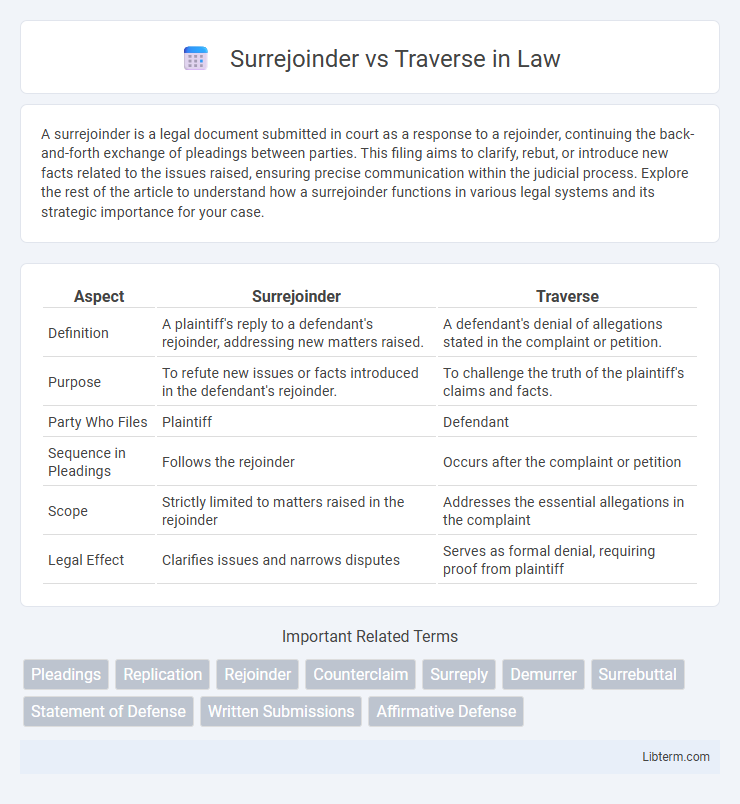A surrejoinder is a legal document submitted in court as a response to a rejoinder, continuing the back-and-forth exchange of pleadings between parties. This filing aims to clarify, rebut, or introduce new facts related to the issues raised, ensuring precise communication within the judicial process. Explore the rest of the article to understand how a surrejoinder functions in various legal systems and its strategic importance for your case.
Table of Comparison
| Aspect | Surrejoinder | Traverse |
|---|---|---|
| Definition | A plaintiff's reply to a defendant's rejoinder, addressing new matters raised. | A defendant's denial of allegations stated in the complaint or petition. |
| Purpose | To refute new issues or facts introduced in the defendant's rejoinder. | To challenge the truth of the plaintiff's claims and facts. |
| Party Who Files | Plaintiff | Defendant |
| Sequence in Pleadings | Follows the rejoinder | Occurs after the complaint or petition |
| Scope | Strictly limited to matters raised in the rejoinder | Addresses the essential allegations in the complaint |
| Legal Effect | Clarifies issues and narrows disputes | Serves as formal denial, requiring proof from plaintiff |
Introduction to Surrejoinder and Traverse
Surrejoinder and traverse are responses in civil litigation expanding the pleadings phase. A traverse specifically denies the truth of facts alleged by the opposing party without introducing new matters, aiming to challenge the plaintiff's claims directly. Surrejoinder is a subsequent pleading filed by the plaintiff after a rejoinder, addressing new issues or defenses raised by the defendant to clarify or counter them further.
Definition of Surrejoinder
Surrejoinder is a legal pleading filed by the plaintiff in response to the defendant's rejoinder, providing further clarification or rebuttal to new issues raised. Unlike traverse, which is a formal denial of allegations in the opponent's pleading, surrejoinder aims to address points of law or fact introduced in the rejoinder. This procedural step ensures that all matters in controversy are adequately contested before trial.
Definition of Traverse
A traverse is a formal written denial of allegations made in a pleading, specifically designed to challenge the truth of the opposing party's claims in legal proceedings. Unlike a surrejoinder, which serves as a reply to a rejoinder, the traverse directly disputes the facts presented, requiring the opposing party to prove the contested statements. This procedural tool ensures that issues of fact are clearly presented and contested for resolution by the court.
Key Differences Between Surrejoinder and Traverse
Surrejoinder is a legal pleading filed by the plaintiff in response to the defendant's rejoinder, while Traverse is a formal denial of specific allegations made in the defendant's pleading. The key difference lies in their function: surrejoinder aims to clarify or rebut new facts introduced in the rejoinder, whereas traverse strictly challenges the truth of the defendant's claims. Surrejoinder is typically a subsequent stage pleading, whereas traverse can be part of the initial defense or reply stages.
Purpose and Role in Legal Proceedings
Surrejoinder serves as a plaintiff's response to the defendant's rejoinder, addressing new facts or defenses introduced, thus maintaining the flow of pleadings. Traverse challenges the truth of the allegations made by the opposing party without introducing new facts, focusing strictly on denial or contestation. Both play distinct roles in legal proceedings to ensure clarity in the issues, with surrejoinder expanding the scope of argument and traverse narrowing the factual disputes.
Procedural Context: When Each is Used
A surrejoinder is filed in response to a rejoinder, usually within trial phases involving pleadings, to clarify or rebut new matters raised by the defendant. A traverse is a formal denial or opposition to allegations made in an earlier pleading, primarily used to contest facts in the initial complaint or subsequent pleadings. Surrejoinders are typically allowed only when court rules or a judge permits further pleadings, whereas traverses are standard procedural tools early in litigation to dispute claims and focus issues for trial.
Drafting a Surrejoinder: Essential Elements
Drafting a surrejoinder requires addressing specific points raised in the traverser's pleadings by presenting clear, concise responses supported by relevant facts and legal grounds. Essential elements include a precise refutation of new arguments introduced in the traverse, proper referencing to prior pleadings, and compliance with procedural rules such as timely filing. Effective surrejoinders enhance case clarity by reinforcing the original claims without delving into issues already settled.
Drafting a Traverse: Essential Elements
A traverse in legal pleadings must clearly deny specific allegations made in the opposing party's complaint or affidavit, identifying each point contested with precision. The draft should avoid general denials, instead providing detailed facts or reasons that challenge the truthfulness or validity of the claims. Essential elements include a concise statement of the contested facts, legal grounds for the denial, and a clear request for relief or judgment in favor of the respondent.
Jurisdictional Variations and Applications
Surrejoinder and traverse exhibit jurisdictional variations in their procedural applications, with surrejoinder primarily recognized in common law jurisdictions allowing a party to respond to a rejoinder, while traverse involves denying specific allegations or facts. In U.S. federal courts, surrejoinder is less common but permitted under Rule 7(a), whereas traverse is frequently used to challenge factual assertions in pleadings across multiple jurisdictions. These differences affect strategic litigation approaches, particularly in civil procedure where regional rules determine the permissible scope and timing of such pleadings.
Conclusion: Importance in Legal Pleadings
Surrejoinder and traverse serve distinct roles in legal pleadings, with surrejoinder providing a plaintiff the opportunity to respond to a defendant's rebuttal, ensuring a comprehensive presentation of facts. Traverse specifically challenges the truth of factual allegations in the opponent's pleadings without addressing substantive defenses, maintaining the integrity of factual disputes. Proper use of surrejoinder and traverse is crucial for clarifying issues, streamlining trials, and upholding procedural fairness in litigation.
Surrejoinder Infographic

 libterm.com
libterm.com